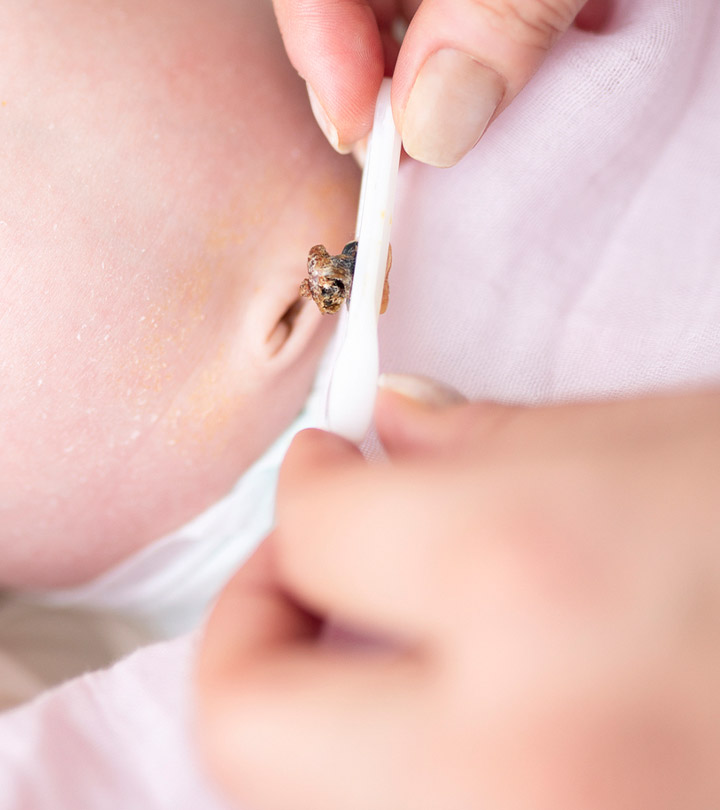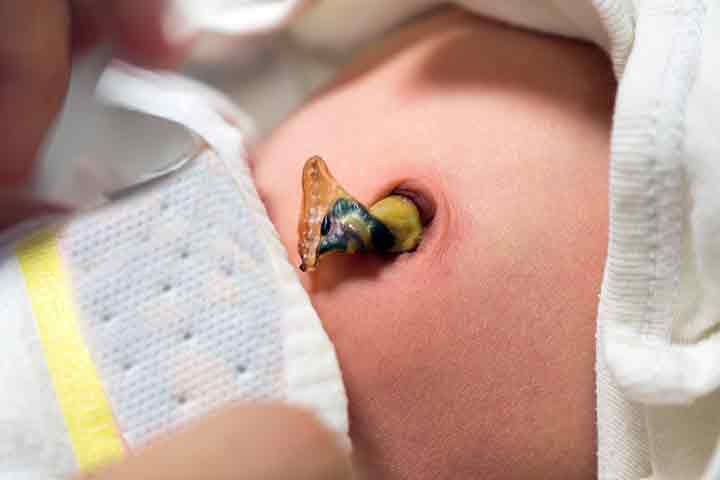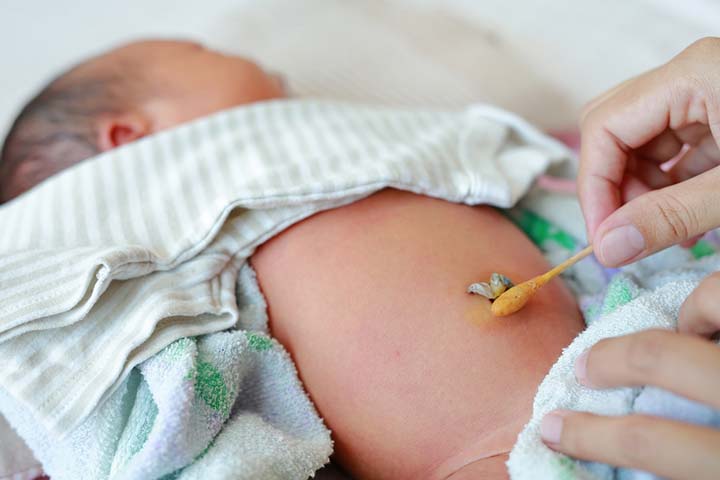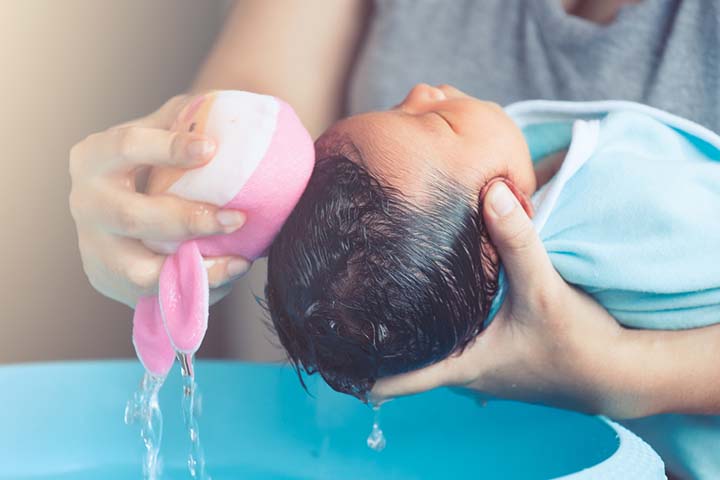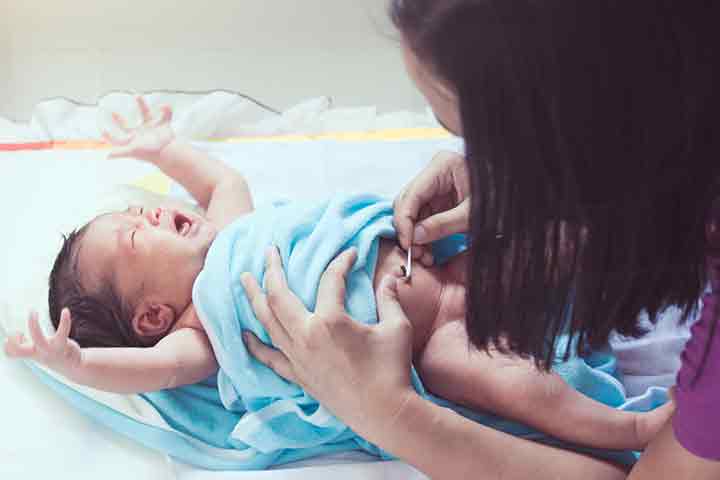The umbilical stump is part of the umbilical cord and falls off after about one to two weeks from birth. Umbilical granuloma in newborns (neonatal umbilical granuloma) can be observed as a tissue overgrowth commonly during the healing of the umbilical cord stump. It is characterized as a soft, pink, and wet lump oozing a clear fluid or fluid with a yellowish tinge (1).
The granuloma is evident after the umbilical cord stump has separated (2). The prevalence of granuloma prevents the tissue from developing around the navel (umbilicus).
This post will help you understand umbilical granuloma in babies, including its causes, symptoms, and treatments.
Causes Of Infant Umbilical Granuloma
The exact cause of infant umbilical granuloma is unknown. It may occur due to an inflammatory reaction to cord separation or a delay in cutting of the cord.Some researchers also believe that the cord-cutting technique may also be responsible for umbilical granuloma in some cases (2).
Signs And Symptoms Of Umbilical Granuloma
The following are the commonly seen symptoms of umbilical granuloma in babies (2).
- A small swelling around the belly button about 1mm to 1cm in size
- Small reddish or pinkish lump visible within the belly button
- Variable amounts of discharge from the belly button that might irritate the surrounding skin.
- Not painful unless accompanied by infection
Eunice Shalom, a mother of two, shares about her daughter’s encounter with umbilical granuloma, “She (her daughter) bathed on the fourth day when I noticed that her umbilical cord is still fresh as it was supposed to be drying or already shrinking.”
They were keeping an eye on the baby and were using methylated spirit to clean it, and the cord eventually fell off. However, two weeks later, she again noticed a discharge from the navel. She shares, “If she (her baby) wears a diaper, it will stain, so I had to pull the diapers down to ensure the place is exposed. I checked and saw something like jelly inside her navel (i).”
When To Call The Doctor?
Call the doctor if you notice any of these signs (1) (3).
- Increasing redness in and around the umbilicus
- Foul-smelling discharge from the umbilicus
- Pink or yellowish discharge when infected
- The lump inside the belly button may appear gray or yellowish if infected
- Clear fluid constantly oozing from the umbilicus
- Baby seems unwell, has fever, and does not feed
- Baby cries when the belly is touched, suggesting the granuloma is painful
Uninfected granuloma does not hurt the baby. Therefore, see a doctor promptly if you notice your baby in pain.
Home Care For Umbilical Granuloma
Parents may follow the steps mentioned below to support granuloma’s healing process. However, a doctor’s evaluation is mandatory before starting any home care (4).
- Wash your hands before and after cleaning around the granuloma to prevent any infections.
- Use a clean and moist swab or cloth to clean any drained fluids. Do not dab the cloth on the umbilicus. Instead, clean any drainage gently without applying any pressure.
- Gently pat the area dry with a clean and dry cloth. Let the umbilicus air dry.
- Avoid submerging the baby in water when bathing until the granuloma dries off.
- You may sponge the baby with warm water and a damp washcloth.
- Roll the top of the diaper and keep it under the navel. It will help promote air circulation to dry the granuloma.
Treatment For Umbilical Granuloma In Babies
The umbilical granuloma usually heals by itself within a week of the postpartum period. However, it is essential to get it checked by the pediatrician since unhealed umbilical granuloma may take several weeks to cure, increasing the risk of infection.
The pediatric healthcare professional may use the following treatment options to treat an umbilical granuloma if it does not resolve by itself within seven to 10 days or if there are signs of infection (2).
1. Topical salt treatment
Topical table salt treatment is an effective and inexpensive remedy for umbilical granuloma. Multiple institutes conducted a systematic review on the effectiveness of salt treatment for umbilical granuloma. The results revealed varying cure rates, spanning from 53.33% to a perfect 100%. The doctor will guide you through the procedure, which consists of the following steps.
- Gently press the sides of the umbilicus to expose the granuloma.
- Apply a small pinch of salt over it.
- Cover the area with a clean gauze piece and let it sit for 30 minutes.
- After 30 minutes, clean the area using a warm damp gauze pad. Let it air dry.
- Repeat it thrice a day for three days.
Use a pinch of salt or in quantity suggested by the doctor to avoid damage to the areas around the umbilicus. Table salt application resolves the granuloma in most cases (5). If you notice no results, speak to the doctor.
2. Topical silver nitrate application
Silver nitrate treatment is one of the most used treatment modalities of umbilical granuloma. It is performed by a physician. The doctor performs three to four applications of silver nitrate on the granuloma in a gap of three to four days.
Silver nitrate has causticiXAbility of a substance to burn and destroy specific body tissues/astringentiXAbility of a substance to shrink or constrict specific body tissueseffects, which could cure granuloma. The procedure may cause minor burns on the skin around the umbilicus. Therefore, this treatment should only be conducted by a healthcare provider who is an expert in the procedure.
3. Surgical interventions
Surgical treatment is usually needed if the granuloma does not respond to salt and silver nitrate treatment. It may be considered the first choice if the granuloma is infected. The doctor may consider any of the following surgical procedures to cure granuloma (6) (7) (8).
- Surgical excision: The granuloma tissue is excised, and silver nitrate is applied to the umbilicus to expedite the healing.
- Surgical ligation: The base of the granuloma is tied with surgical threads to cut the blood supply to the tissue. It causes the tissue to die and fall off in one to two weeks.
- Electrocautery: It is a cauterizationiXA medical intervention that uses heat or electricity to burn or seal an injury procedure where an electrocauter is used to burn and destroy the granuloma.
- Cryosurgery: The granuloma tissue is subjected to extremely cold temperatures, causing it to die. The doctor may use liquid nitrogen or argon gas to perform this procedure.
Prevention Of Umbilical Granuloma In Infants
There is no way to prevent umbilical granuloma since its causes are not fully known. Research suggests that proximal clamping may reduce the risk of umbilical granuloma compared to conventional clamping (2). Proximal clamping is clamping the umbilical cordiXA tube-like structure that delivers oxygen and nutrition to the fetus in the womb very close to the newborn’s body. Maintaining good hygiene until the umbilical stump falls off may also reduce the risk of granuloma.
Umbilical granuloma in newborns is a common and natural occurrence that generally heals on its own. Although mild symptoms do not harm the baby, be mindful of any change in the granuloma and if it irritates your baby. In order to avoid such discomfort, it is advisable to take care of the umbilical stump to prevent it from getting infected and avoid other problems such as umbilical granuloma. If you have any concerns about umbilical cord stump care, talk with a doctor for early detection and treatment of any issue.
Key Pointers
- Umbilical granuloma is a lump of tissue formed on the infant’s naval after the separation of the umbilical cord.
- An inflammatory reaction or a delay in cutting the umbilical cord can result in the granuloma.
- Discharge from the naval area or signs of fever and discomfort should be immediately reported to the pediatrician.
- Topical silver nitrate, topical salt, and other treatment options as you read through.
Learn how to treat and take care of your baby’s umbilical cord after birth in this video. Get tips on how to prevent and treat umbilical granuloma.
